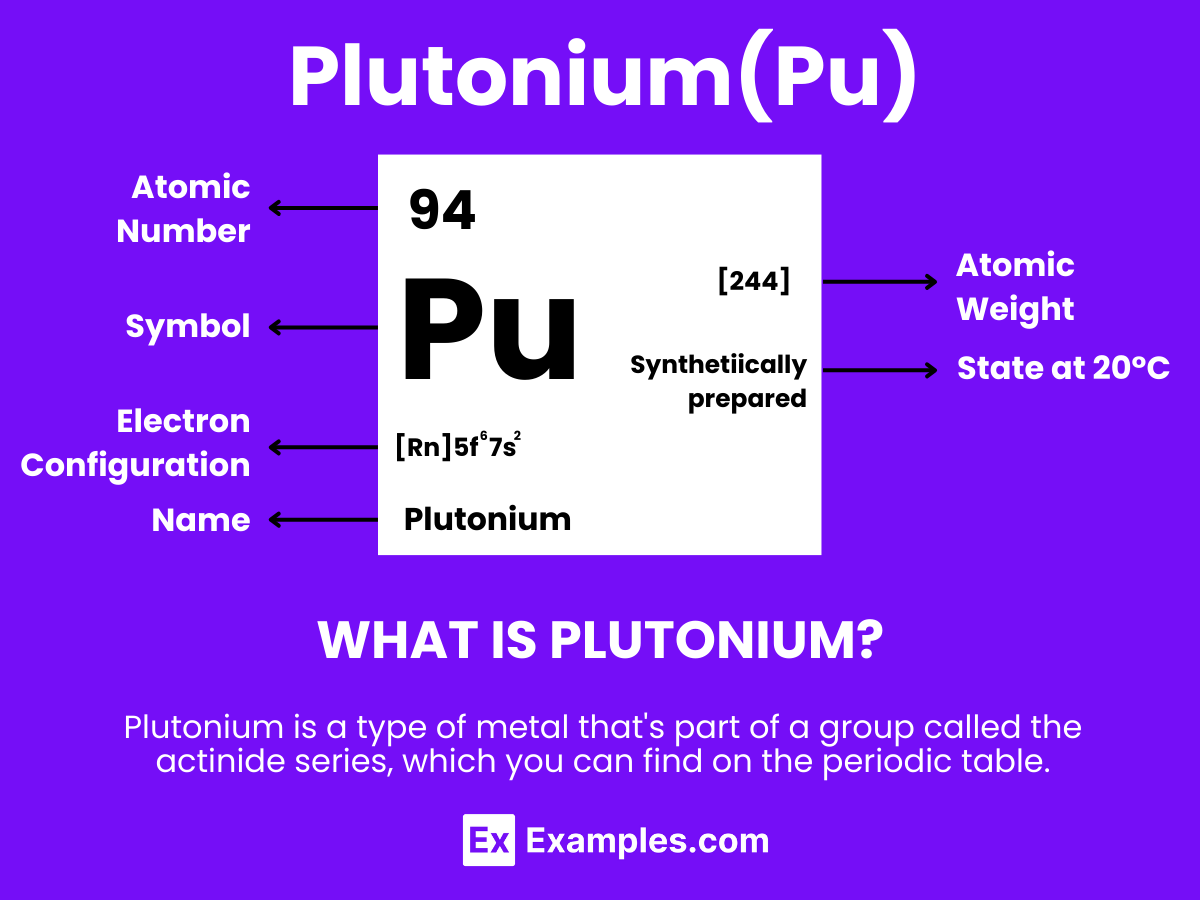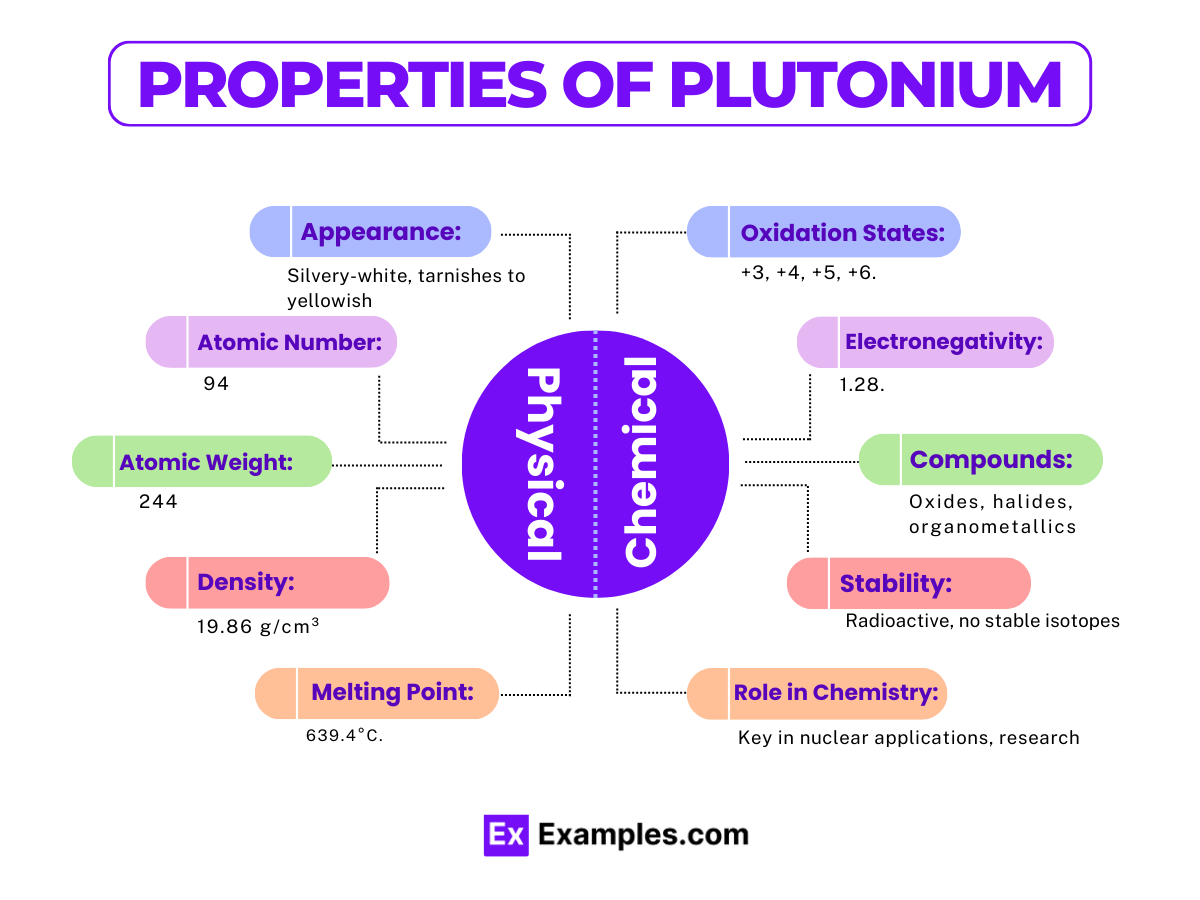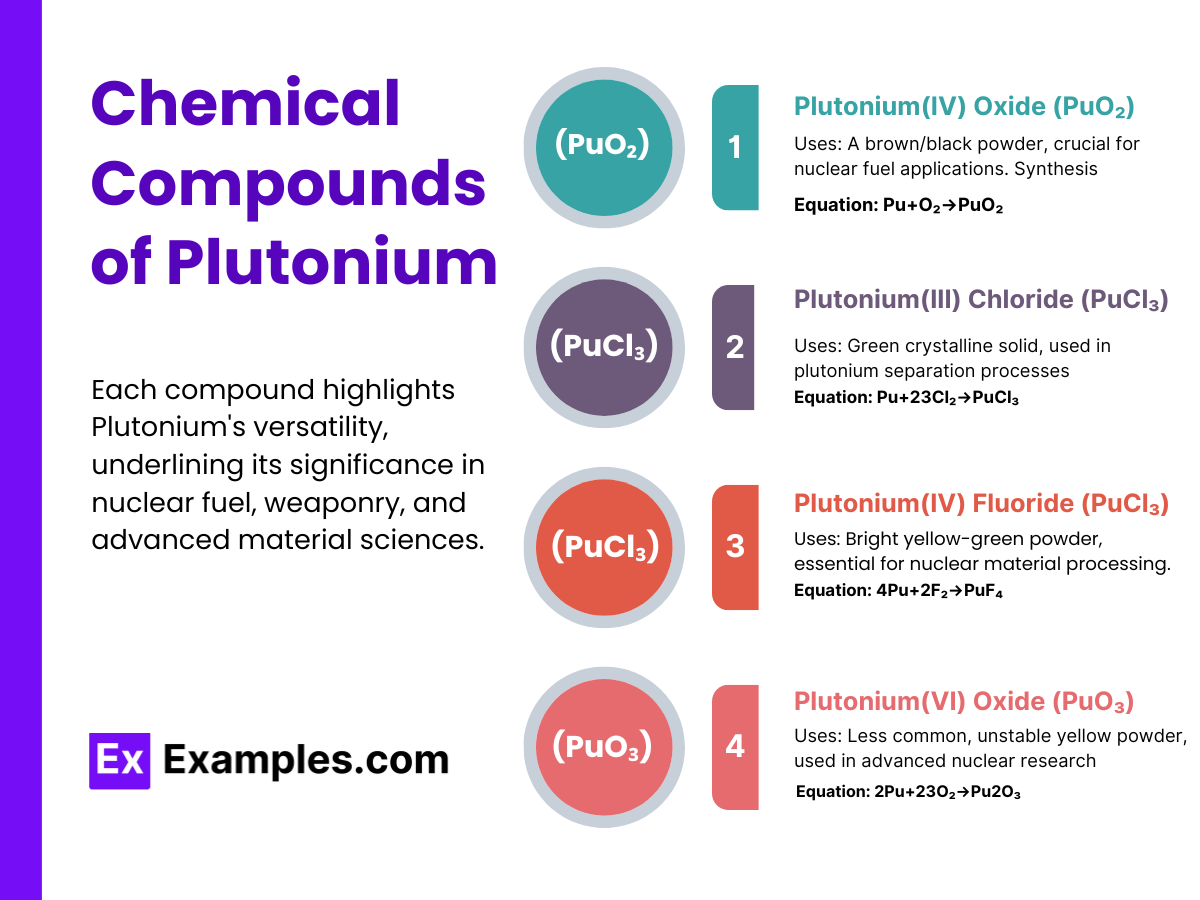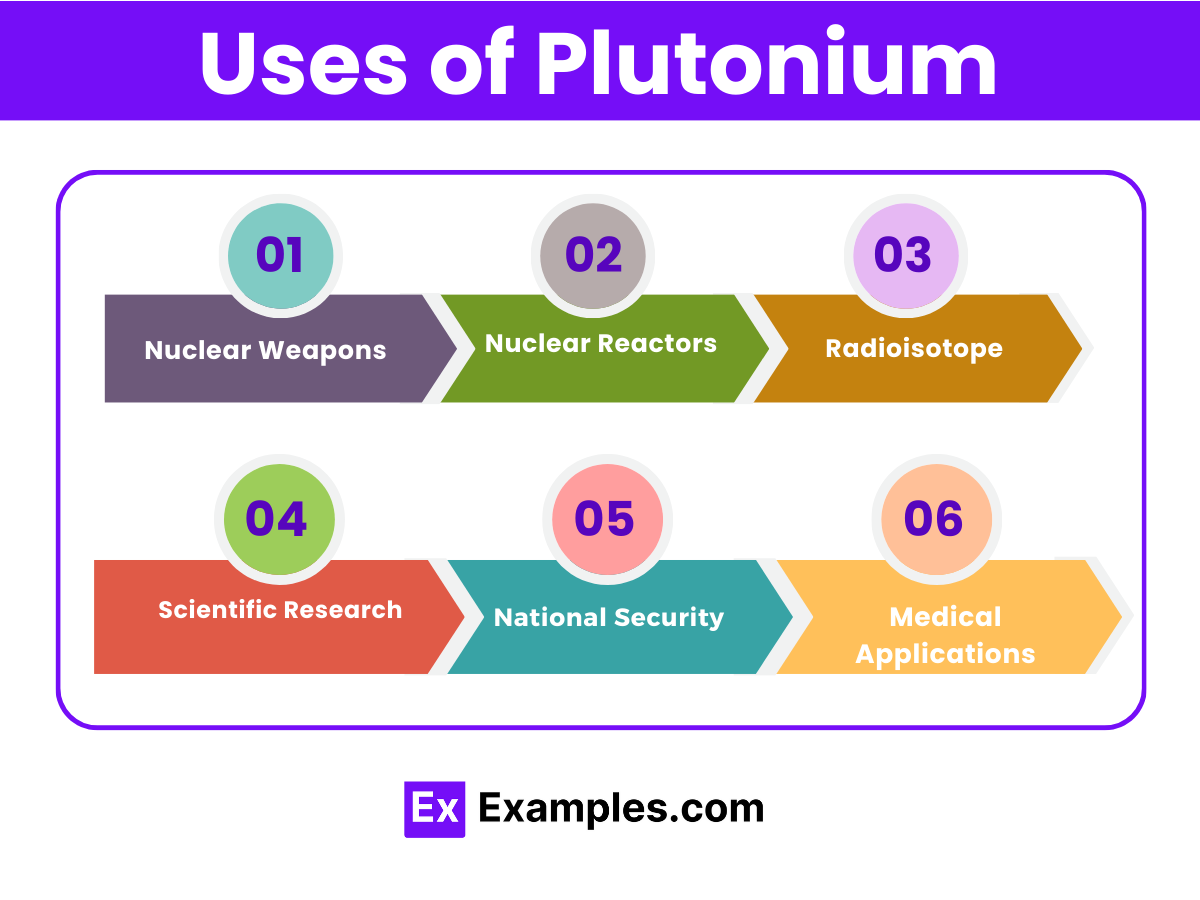Plutonium
Discover the intriguing world of Plutonium, a pivotal element in the realm of nuclear science and technology. Plutonium, with its complex characteristics and applications, stands at the forefront of advancements in energy and defense. This guide delves into the fascinating aspects of Plutonium, from its discovery to its role in powering spacecraft and strengthening national security. Through real-life examples, we unveil the multifaceted uses of Plutonium, showcasing its significance in modern technology and research. Embark on a journey to explore the compelling narrative of Plutonium, a key player in shaping our understanding and utilization of nuclear energy.
Actinides
| Actinium | Berkelium |
| Thorium | Californium |
| Protactinium | Einsteinium |
| Uranium | Curium |
| Neptunium | Mendelevium |
| Fermium | Nobelium |
| Americium | Lawrencium |
What is Plutonium?
Plutonium is a synthetic, silvery-gray metallic element with the atomic number 94, known for its critical role in nuclear energy and weaponry due to its high radioactivity and ability to sustain a nuclear chain reaction. Unlike naturally occurring elements, Plutonium is produced in nuclear reactors by bombarding Uranium-238 with neutrons, making it pivotal in the manufacture of nuclear weapons and as a reactor fuel. Beyond its nuclear applications, Plutonium powers thermoelectric generators in spacecraft for long-duration missions. However, its radioactive nature and potential health risks necessitate strict safety and environmental protocols to manage its use and mitigate impacts on human health and the environment
Plutonium Formula
- Formula: Pu
- Composition: Consists of a single plutonium atom.
- Bond Type: In its elemental form, plutonium does not form bonds as it is a pure element. However, plutonium can form covalent or ionic bonds when reacting with other elements.
- Molecular Structure: As a pure element, plutonium does not form a molecular structure in the same way compounds do. At room temperature, plutonium exists in a metallic state with a complex crystalline structure, including six allotropes that vary under different temperature conditions. The most common at room temperature is the α (alpha) phase, which has a monoclinic crystal structure.
- Electron Sharing: In compounds, plutonium typically engages in covalent bonding by sharing electrons or in ionic bonding by transferring electrons, depending on its reaction with other elements.
- Significance: Plutonium is known for its role in nuclear energy and weapons due to its ability to sustain a chain reaction. Plutonium-239, in particular, is a key fissile material for nuclear reactors and atomic bombs. Additionally, Plutonium-238 is used in radioisotope thermoelectric generators (RTGs) for powering spacecraft and remote devices, benefiting from its high decay heat and long half-life.
- Role in Chemistry: Plutonium’s significant role extends beyond its radioactive properties to its chemistry, including its use in research on superheavy elements and in studying complex actinide chemistry. Its behavior in the environment and potential for use in advanced nuclear fuel cycles also marks it as a critical element in nuclear science and engineering. Plutonium’s compounds and alloys are studied for their unique electronic, magnetic, and chemical properties, making it a vital element in the advancement of materials science and technology.
Atomic Structure of Plutonium
Overview
- Symbol: Pu
- Atomic Number: 94
- Part of the actinide series
- Key isotopes: Plutonium-239 and Plutonium-241
Electron Configuration
- Configuration: [Rn] 5f⁶ 7s²
- Six electrons in the 5f orbital
- Two electrons in the 7s orbital
Nuclear Composition and Isotopes
- Nucleus consists of 94 protons
- Varies in the number of neutrons across isotopes
- Plutonium-239: Notable for its use in nuclear reactors and weapons
Physical and Chemical Properties
- Appearance: Silvery metal that tarnishes in air
- Six allotropes under ambient pressure
- Highly reactive with oxygen, acids, and halogens
Handling and Safety
- Radioactive and capable of spontaneous fission
- Toxicity concerns, especially through inhalation
- Safety protocols include glove boxes and sealed containers
Applications
- Critical in nuclear power generation
- Used in the manufacturing of nuclear weapons
- Research into its complex chemistry and physics
Environmental and Health Risks
- Long-lived radioactive contaminant
- Potential for bioaccumulation
- Stricter regulations for disposal and handling.
Properties of Plutonium
Physical Properties of Plutonium
| Property | Description |
|---|---|
| Appearance | Silvery-gray metallic; tarnishes to a dull gray in air |
| Atomic Number | 94 |
| Atomic Mass | 244 u |
| Density (at room temperature) | 19.86 g/cm³ |
| Melting Point | 639.4 °C (1182.9 °F) |
| Boiling Point | 3228 °C (5842.4 °F) |
| State at Room Temperature | Solid |
| Crystal Structure | Monoclinic (alpha), Face-centered cubic (delta) at higher temperatures |
| Thermal Conductivity | 6 W/(m·K) (at 25 °C) |
| Electrical Conductivity | Relatively poor conductor of electricity |
| Radioactivity | Highly radioactive, primarily alpha emitter |
Chemical Properties of Plutonium
Plutonium, a synthetic element with the symbol Pu and atomic number 94, exhibits a complex array of chemical properties, making it a subject of extensive study within nuclear chemistry. As a member of the actinide series, Plutonium shares characteristics with other radioactive elements, displaying multiple oxidation states and reacting with various non-metals. Its chemical behavior is not only pivotal for understanding nuclear reactions but also for the safe handling and storage of nuclear materials.
Oxidation States and Reactivity: Plutonium can exist in multiple oxidation states, ranging from +3 to +7, with +4 (PuO₂ ) and +3 (Pu₂O₃) being the most stable. This variability in oxidation states allows Plutonium to form a variety of compounds, including oxides, halides, and hydrides. For instance, Plutonium reacts with oxygen to form PuO, PuO₂ , and Pu₂O₃, with Plutonium dioxide (PuO₂) being the most significant due to its use in nuclear fuel:
2 Pu+O₂→2 PuO₂
Reaction with Acids and Halogens: Plutonium dissolves in acidic solutions, forming Pu(IV) ions, and reacts vigorously with halogens to produce halides. For example, the reaction with chlorine gas yields Plutonium tetrachloride (PuCl₄):
Pu+2 Cl₂ →PuCl₄
Hydride Formation: When exposed to hydrogen gas, Plutonium forms Plutonium hydride (PuH2+x), a reaction critical for understanding Plutonium’s behavior in nuclear storage conditions:
Complexation and Solubility: Plutonium’s ability to form complex ions affects its solubility and mobility in the environment, particularly in water and biological systems. Its interaction with organic and inorganic ligands can stabilize various Plutonium species, influencing its bioavailability and environmental impact.
Radioactive Decay and Transmutation: Plutonium undergoes alpha decay, transforming into other actinides and eventually leading to stable isotopes. For example, Pu-239 decays to Uranium-235, a process that is fundamental to the operation of nuclear reactors and the formation of nuclear weapons:
Environmental and Safety Considerations: The chemical properties of Plutonium, particularly its reactivity and radioactivity, necessitate rigorous safety protocols in its handling, storage, and disposal. The potential for environmental contamination through leaching, airborne particles, or nuclear accidents underscores the importance of understanding Plutonium’s chemical behavior.
Thermodynamic Properties of Plutonium
| Property | Value |
|---|---|
| Melting Point | 639.4 °C (1182.9 °F) |
| Boiling Point | 3228 °C (5842.4 °F) |
| Heat of Fusion | 2.82 kJ/mol |
| Heat of Vaporization | 333.5 kJ/mol |
| Specific Heat Capacity (@25 °C) | 35.5 J/(mol·K) |
Material Properties of Plutonium
| Property | Value |
|---|---|
| Density (@20 °C, α-phase) | 19.86 g/cm³ |
| Thermal Conductivity | 6.74 W/(m·K) |
| Electrical Resistivity (@20 °C) | 1.460 microohm-meters |
| Young’s Modulus | 96 GPa |
| Poisson’s Ratio | 0.21 |
Electromagnetic Properties of Plutonium
| Property | Value |
|---|---|
| Electrical Conductivity | Variable; dependent on allotrope and purity |
| Magnetic Ordering | Paramagnetic at room temperature (α-phase) |
| Superconductivity | Not naturally superconducting; can become superconducting under high pressure |
Nuclear Properties of Plutonium
| Property | Value |
|---|---|
| Atomic Number | 94 |
| Isotopes | Mainly Pu-238, Pu-239, Pu-240, Pu-241 |
| Half-life of Pu-239 | 24,110 years |
| Neutron Cross Section (Pu-239) | 749 barns (for thermal neutrons) |
| Critical Mass (Pu-239) | ~10 kg (spherical configuration) |
Preparation of Plutonium
Introduction
- Plutonium, a synthetic element, is not found naturally.
- Primarily produced in nuclear reactors.
- Key component for nuclear energy and weapons.
Methods of Production
- Neutron Bombardment of Uranium-238: Most common method, where Uranium-238 absorbs neutrons and undergoes beta decay to form Plutonium-239.
- Breeder Reactors: Special reactors designed to produce more fissile material (Plutonium-239) than they consume (Uranium-238).
Steps Involved in Plutonium Preparation
- Irradiation: Uranium rods are placed in a nuclear reactor to absorb neutrons.
- Cooling: Spent fuel rods are cooled to reduce radioactivity levels.
- Chemical Separation: Chemical processes, such as PUREX (Plutonium-Uranium Extraction), are used to separate plutonium from uranium and other fission products.
- Purification: Further chemical reactions purify the plutonium, removing contaminants.
Handling and Safety Measures
- Containment: Operations are conducted in shielded facilities to protect workers from radiation.
- Remote Handling: Robotic arms and remote-controlled tools are used for handling radioactive materials.
- Personal Protective Equipment (PPE): Essential for workers to prevent inhalation or ingestion of radioactive particles.
Environmental Considerations
- Waste Management: Spent nuclear fuel and by-products must be safely stored or reprocessed.
- Radiation Control: Monitoring and controlling releases of radiation to the environment.
Chemical Compounds of Plutonium
1. Plutonium(IV) Oxide (PuO₂)
A brown/black powder, crucial for nuclear fuel applications. Synthesis
equation:
2. Plutonium(III) Chloride (PuCl₃)
Green crystalline solid, used in plutonium separation processes.
Formation reaction:
3. Plutonium(IV) Fluoride (PuF₄)
Bright yellow-green powder, essential for nuclear material processing.
Synthesized by: 4
4. Plutonium(IV) Nitrate [Pu(NO₃)₄]
A soluble compound, pivotal for plutonium extraction and purification steps.
Prepared through:
5. Plutonium(VI) Oxide (PuO₃)
Less common, unstable yellow powder, used in advanced nuclear research.
Formation process:
6. Plutonium(III) Hydride (PuH₃)
A pyrophoric compound that reacts with air, used in nuclear research.
Generated via:
Isotopes of Plutonium
| Isotope | Half-Life | Decay Mode |
|---|---|---|
| Pu-238 | 87.7 years | Alpha decay |
| Pu-239 | 24,110 years | Alpha decay |
| Pu-240 | 6,563 years | Alpha decay |
| Pu-241 | 14 years | Beta decay to Americium-241 |
| Pu-242 | 373,300 years | Alpha decay |
| Pu-244 | 80 million years | Alpha decay |
Uses of Plutonium
- Nuclear Weapons: Plutonium-239 is a primary fissile isotope used in the core of nuclear weapons due to its ability to sustain a nuclear chain reaction.
- Nuclear Reactors: As a fuel in nuclear reactors, particularly in Mixed Oxide (MOX) fuel, where it is blended with uranium to power reactors.
- Radioisotope Thermoelectric Generators (RTGs): Plutonium-238 provides a heat source due to its high radioactivity, powering spacecraft and satellites.
- Scientific Research: Studies on nuclear fission, safety measures, and waste management in the nuclear energy sector.
- National Security: Monitoring and safeguarding plutonium stockpiles is crucial for international security and non-proliferation efforts.
- Medical Applications: Plutonium-238 has been used in pacemakers to provide a long-lasting power source.
- Research on Superheavy Elements: Plutonium serves as a target material in accelerators for producing superheavy elements.
- Advanced Nuclear Fuels: Research into mixed oxide (MOX) fuel explores using plutonium in combination with uranium for more efficient nuclear fuel
Production of Plutonium
Plutonium is primarily produced in nuclear reactors through neutron irradiation of Uranium-238 (U-238), one of the most common isotopes of uranium found in nature. The process begins when U-238 absorbs a neutron and becomes Uranium-239 (U-239), which is unstable. Through beta decay, U-239 transforms into Neptunium-239 (Np-239), and subsequently, Np-239 undergoes another beta decay to become Plutonium-239 (Pu-239), a process that can be represented by the following equations:
U-238+n→U-239
This production method highlights the synthetic nature of Plutonium, as it does not occur naturally in significant amounts on Earth. The Plutonium produced can then be chemically separated from the spent nuclear fuel through various reprocessing methods, such as PUREX (Plutonium-Uranium Extraction), making it available for further use.
Applications of Plutonium
Plutonium’s unique properties have led to a wide range of applications, most notably in nuclear energy and weaponry.
- Nuclear Weapons: Plutonium-239 is a key material in the construction of nuclear weapons due to its high fissionability. When Pu-239 undergoes fission, it releases a tremendous amount of energy, which is the destructive force of nuclear weapons.
- Nuclear Reactors: Plutonium is used as a fuel in certain types of nuclear reactors, including mixed oxide (MOX) fuel, which contains both plutonium and uranium. MOX fuel is utilized to generate electricity, demonstrating Plutonium’s role in civilian energy production.
- Radioisotope Thermoelectric Generators (RTGs): Plutonium-238, due to its steady decay and heat generation, is used as a power source in RTGs. These generators provide electricity for spacecraft, satellites, and remote terrestrial applications, where solar power is unfeasible.
- Research: Plutonium plays a crucial role in scientific research, particularly in studies related to nuclear physics, chemistry, and materials science. Its complex behavior under different conditions provides valuable insights into the properties of actinide elements.
- Nuclear Waste Management: Understanding Plutonium’s chemical and physical properties is essential for developing effective strategies for the long-term storage and disposal of nuclear waste. Plutonium’s long half-life necessitates solutions that ensure its safe isolation from the biosphere
Plutonium has illuminated its multifaceted roles in science, energy production, and beyond. This dense material, pivotal for its applications in nuclear reactors and medicine, underscores a blend of challenge and opportunity. Our journey through its properties, uses, and implications not only enriches our understanding but also propels forward-thinking in harnessing its potential resonsibly.






